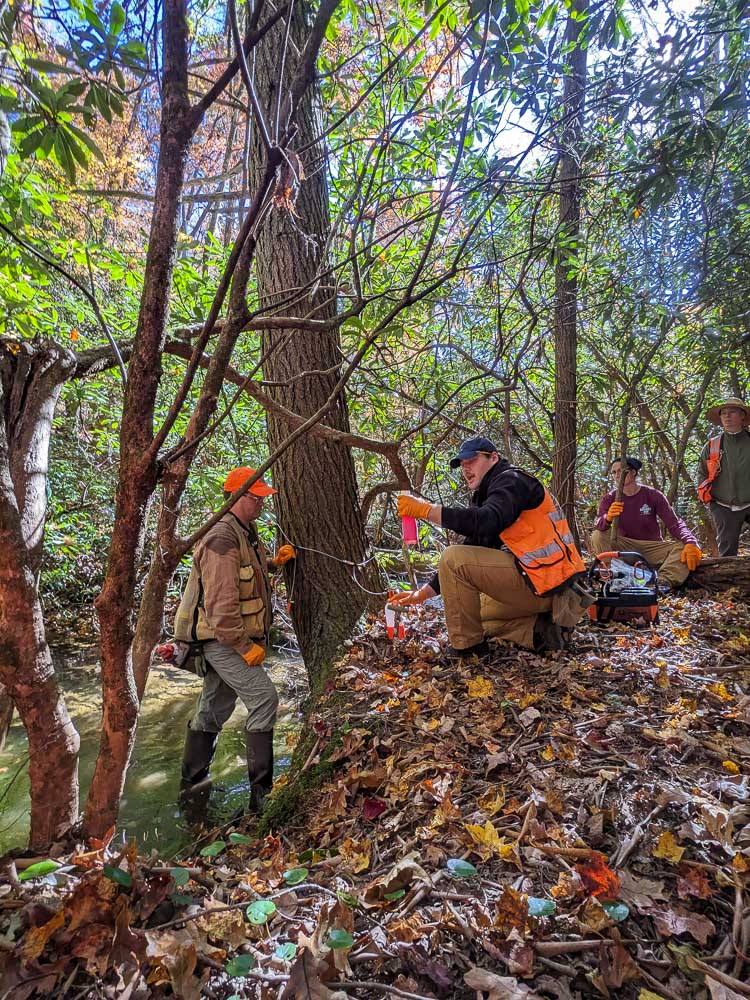What We’re Doing to Save our Hemlocks

There’s been a lot of activity at Conserving Carolina on the hemlock front lately! Earlier this month, Thom Green and Olivia Hall of the Hemlock Restoration Initiative presented Hope for the Hemlocks to an inquisitive audience at Walnut Creek Preserve. HRI works with many partners in this region to protect hemlocks and also helps educate private landowners on how to best manage their hemlocks. Then just last week, our stewardship team wrapped up the 2023/2024 hemlock treatment season on Conserving Carolina’s properties. Read on for all the latest updates!
But first, you may be wondering: What are hemlocks and what is going on with them?
Hemlocks for Beginners

Two species of conifer trees called hemlocks are native to our region: Eastern hemlock (Tsuga canadensis) and Carolina hemlock (Tsuga caroliniana). Eastern hemlocks are widespread on the east coast from Appalachia to Canada, but Carolina hemlocks are endemic to the Southern Appalachians. Easterns can be found in a variety of habitats, especially along streams, while Carolinas prefer dry, sunny mountain bluffs. Both the Eastern and Carolina hemlocks are keystone species. They each play a unique role in our forests.
Sadly, these iconic trees are under attack from the hemlock woolly adelgid (HWA), an invasive sap-sucking insect. HWA was found in the Eastern U.S. in the mid-20th century. By the early 2000’s, infestation became widespread across the Southern Appalachians.
Eastern and Carolina hemlocks are tough trees that used to live for hundreds of years. But they didn’t evolve alongside HWA, and so have little natural resistance. Without intervention, this tiny insect can kill a mighty hemlock in just a few years.
You don’t have to look too far in our forests now to find distressed and deceased hemlocks. Telltale signs of infestation include defoliated branches, white cottony egg sacs on the underside of branches, and trees putting out an overabundance of cones. The standing skeletons of dead hemlocks are sometimes called “gray ghosts.”
Current Best Practices for Hemlock Treatment

HWA is a decades old problem now. Thankfully, there’s a growing body of research about HWA, which has led to more effective and economical hemlock treatments. Integrated pest management is now the gold standard, combining multiple approaches for the best outcome.
Chemical treatment of trees is still the first step to prevent hemlocks from dying of HWA. Thankfully, the chemicals are now much less expensive: one large hemlock can now be treated every 7 years or so for less than $10. At this time, research indicates that the ecological benefits of treatment outweigh the risks. Choose an application method wisely, based on the tree’s location. For hemlocks growing near water or flowering plants, trunk injection or basal bark spray may be best.
In Japan and the Pacific Northwest, HWA’s native habitat, predator beetles keep its numbers in check. Some of these species feed exclusively on HWA, like the Laricobius a.k.a., “Lari” beetle. The “Lari” beetle is one of several insects now approved as biological controls for HWA. These beetles are being released across the Eastern U.S., with some evidence that they are helping. While scientists don’t expect predator beetles to eradicate HWA, over time they can help reduce adelgid populations and the need for chemicals.
New research shows that opening up the canopy around deeply shaded hemlocks can be a good addition to chemical treatment. Infested hemlocks receiving more direct sunlight are often healthier than shaded hemlocks.
There are also ongoing research efforts to conserve the genetics of these threatened species and to breed HWA-resistant trees.
“To landowners who want to treat their hemlocks but aren’t sure where to start: it’s easier than it sounds,” says HRI’s AmeriCorps member Olivia Hall. “The application is relatively simple, inexpensive, and surprisingly effective. There are a number of different treatment options to choose from to best fit your situation, including hiring a professional. We are here to help if you need us.”
2023/2024 Treatment Season on Conserving Carolina Lands

Over the last few months, Conserving Carolina’s stewardship team has worked closely with HRI staff and Project Conserve members to treat hemlocks on lands we own. As is the case across Southern Appalachia, hemlocks on our lands are suffering widespread HWA infestation, with some trees already deceased. Some stands were treated in 2016, and as expected are in better condition than untreated stands.
Staff first identified five hemlock stands of highest priority for treatment at Forks of Reasonover Preserve, Florence Nature Preserve, Wildcat Rock Nature Preserve, and Transfiguration Preserve. These hemlock stands are still healthy enough for treatment to possibly save them. They are also located in ecologically sensitive areas home to rare plants and animals.
This season, the team chemically treated over 600 hemlock trees across 35 acres, carefully selecting the application method based on the location. In future years, our land management team will continue to evaluate and treat our hemlocks, with the goal of preserving the integrity of sensitive ecosystems that would suffer most from losing these special trees.
“At Conserving Carolina, we value and prioritize natural community integrity,” says Botanist and Land Management Coordinator Ruth Cumberland, who led this year’s hemlock treatments. “With the continued treatment of our hemlock stands, our stewardship team feels pride acknowledging these unique plant community assemblages will continue to survive. Humans brought the Hemlock Wolly Adelgid to our biodiverse landscape and I believe it is our moral obligation to try, as best we can as responsible land managers- as responsible stewards- to help protect our wonderful hemlock trees from this invasive-exotic aphid.”

Conserving Carolina’s stewardship team extends their deep gratitude to the Hemlock Restoration Initiative for their assistance and guidance during this treatment season! Landowners who would like more advice on treating their hemlocks can contact HRI by calling (828) 252-4783 or emailing [email protected].